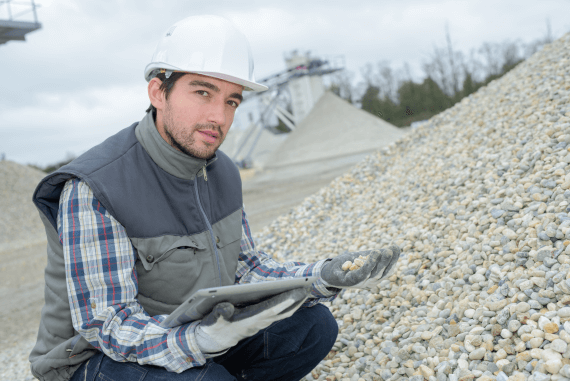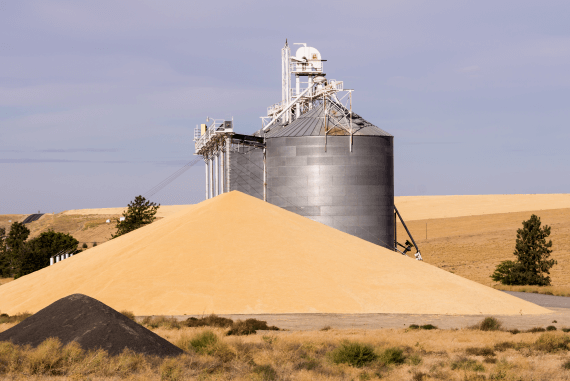- Home ››
- Health and Safety Training ››
- Articles ››
- Dangers from Free-Flowing Solids
Dangers from Free-Flowing Solids
Introduction

The term free-flowing solids describes substances which are comprised of many small individual solid pieces which together can cause the same dangers as a liquid. Typical examples include sand or gravel, and are obviously common substances used in many places of work around the world, particularly construction sites.
Whilst technically sand and gravel are classed as solids because of the molecular make-up of each individual piece, their small size combined with the presence of thousands or millions of pieces gives the overall mass the same properties as liquids in terms of being able to take the shape of their container and allowing movement "through" the overall mass.
Of course, this means that many of the same dangers associated with liquids are also present from free-flowing solids. Whilst sand and gravel will usually be transported and stored in relatively small bags, substances such as grain will typically be stored in large silos. Anybody unfortunate enough to fall into one of these silos will find the grain is similar to liquid, in that the person will probably sink to the bottom and struggle to breathe, which is likely to result in death. This is why, although rare and unlikely to be found in the quantity needed to pose a likely danger in the majority of workplaces, free-slowing solids are just as much of a risk to the health and safety to workers in certain industries as liquids are.
The Need for Health and Safety Training
A good health and safety training programme for staff members will include time spent going over the potential risks to health that are present from free-flowing solids, and will obviously be even more pertinent to those workplaces which have an increased risk of this danger such as construction sites or agricultural businesses.
The training courses or sessions should also take into consideration other related risks. These include:
Falling From Height
Being high up and falling into a tall grain silo or other large container filled with free-flowing solids is dangerous, but so too is going the other way and falling a long way to the ground. Suitable precautions, working at height training and safety features all need to be combined to minimise the risks to those workers whose job role entails working at height.
Only those who have been suitably trained should be allowed or asked by management to go up that high, rather than just sending any employee up there.
COSHH
The small nature of these individual pieces means that either they themselves or the dust that can be released when they are moved means that there is often a COSHH risk present where free-flowing solids are concerned, as exposure to the dust such as through inhalation can cause health problems. This is particularly the case when this exposure takes place over a long period of time and accumulates in the lungs.
Even if it does not cause chronic diseases, this material can still have health issues and aggravate conditions such as asthma, making breathing difficult and generally affecting the welfare and well-being of employees. So just because it may not cause life-threatening illnesses does not mean that companies should not take steps to eliminate or reduce the hazard.
Manual Handling
Even if the quantity of the free-flowing solids is not enough for a person to fall in and get trapped, they are still likely to be stored in bags or other containers which are extremely heavy. There is therefore a strong probability of a manual handling injury occurring if the person has to lift or move these containers. Manual handling training will be essential in order to teach correct lifting/moving techniques and to minimise the risk of working days lost through workers having to take time off from work to recover from any manual handling related injuries.
Although it is unlikely that a manual handling issue will lead to death or a life-threatening situation as other health and safety risks in the workplace can, it is a fact than manual handling injuries are one of the leading causes for workers to have to take time off away from the business. This is another reason why potential hazards like manual handling issues need to be taken seriously and given full attention when conducting risk assessments and implementing safety controls, as the financial impact to the company can be immense if they ended up losing large numbers of their employees for long periods of time with ailments like bad backs, strained muscles and torn ligaments for example.
Crush Injuries
As mentioned in the Manual Handling point above, bags of free-flowing solids are likely to be extremely heavy. Just as they can cause manual handling injuries, they are also cable of causing crush injuries if a person were to get a part of their body such as their foot or their hand between the bag and a solid surface.
Some workplaces such as quarries have enormous piles of small stones and gravel that tower many metres into the air and have a wide base, meaning that there is a great deal of material contained in the pile. If a person were to be stood next to it if this pile were to give way, they could be crushed by the sheer weight of this large volume of material pressing down on them.
Conclusion

The level of danger posed by free-flowing solids will vary greatly between different workplaces and industries. For some the risk will be non-existent, whereas for others the threat is constant and needs actively managing each and every day.
This is why there is no one-size-fits-all approach to health and safety, or indeed the content of the health and safety training provided to a workforce. Comprehensive risk assessments need to be undertaken to determine the specific and unique risks that staff and visitors alike may encounter when on the site or premises, so that steps can be taken proactively to eliminate or reduce risk as far as is reasonably practical before an incident occurs (which hopefully it will not).


